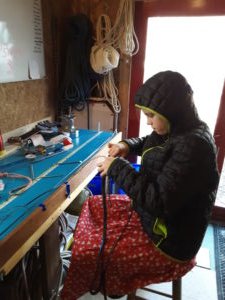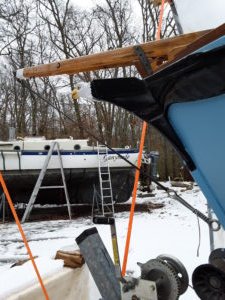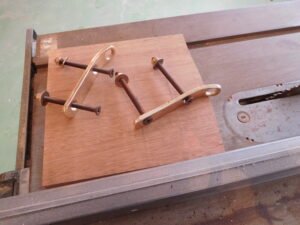
When King Solomon famously said that there is a season for everything, he obviously had not been to New England in February. During autumn, the season devoted to preparing for winter, I had made some attempts at insulating my shop so that winter could be more productive. But having found neither time nor resources to really get some good insulation in, my half-hearted efforts yielded predictable results: in short, it’s cold out there, and there’s a limit to how long I can stand on freezing concrete slab, and to what things I can even do.
Luckily, the warm house is right there, and when a chill starts travelling up the legs too much, I can simply pop in there for a cozy cup of tea next to the wood stove. What I can’t do, however, is bring in all the things I want to paint and varnish, which limited my work on the schooner this winter, since paint and varnish are the two things it needs the most.
Having put those to one side since the hard frost began, I did find a few things to chip away at: most importantly the rigging. While it’s unpleasant to splice with cold hands, it is at least possible, and the girls and I put together a whole gang of new rigging for the schooner, working here and there in little bits. The old standing rigging was swaged stainless steel wire, and while I’m not upgrading much else on the boat, it seemed like it would be a waste, having both the skill and materials to do a really nice synthetic shroud job, not do it.



I had a good bit of Marlow’s pre-stretched, quarter-inch, SK78 MAX dyneema left over from a long-ago job: just the thing for small boat shrouds, and a nice material for the girls to learn to splice with. We made mostly soft eyes aloft, with dyneema sleeve to prevent wear, and closed thimbles alow to replace the wooden deadeyes. Though deadeyes fit the schooner’s look perfectly, these were a little too big around, with lanyard holes too rough to get the tension right, and cutting them down would have meant more work than making new. And for shrouds that small, a teardrop thimble takes the lanyard perfectly well, and tradition can only sway me so far. Most of the halyard blocks are now attached with soft rope strops, and hopefully everything will run more smoothly and with less chance of chafe. I know, a 20-foot gaff-rigged schooner is hardly a high-performance boat, but why not give her every advantage that reason permits?

Another thing the season allowed was the fabrication of several parts: the original gooseneck had half-way torn out, and the bowsprit shroud chainplates were cracked from being loaded unfairly. Now when I built Ganymede, I had bought bronze plate stock to cut chainplates and other fittings out of, and have been toting the scraps around ever since, hoping to find a good use for them. Here it was at last: ten years of moving the scraps from box to bin finally paid off in a pair of elegant chainplates, which, though far thicker than they need to be, were the right material by virtue of being what I had. Another Ganymede fitting rendered obsolete by the her cockpit redesign was cut down for a gooseneck.
All these bits of hardware, as well as four portholes that I took out so I could paint, plus a couple of new portholes from the consignment shop, are waiting for weather warm enough that I can go out there and install them. As the season loiters on to its appointed end, a day of lower 40s comes along here and there, which I leap on to slosh a coat of paint or primer here and there. It’s not that I’m using paint that requires warm weather to apply—it’s that I require a minimum temperature to crawl around inside a tiny boat cabin. Still, seizing the day whenever I could, I’ve got the inside fairly presentable, ready to install a huge pile of things just as soon as the season will relent and let things go above 50 degrees again. When that will be I’ll bet even Solomon wouldn’t know.


